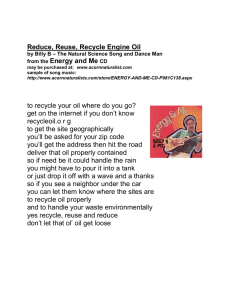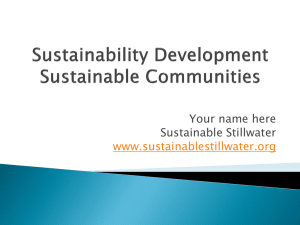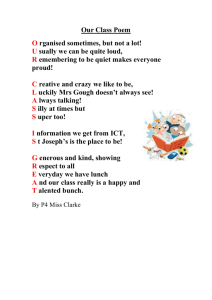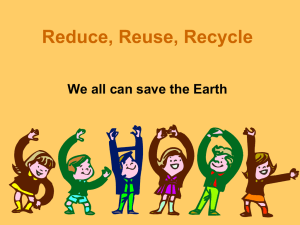Unit Abstract - Airport Community Schools
advertisement
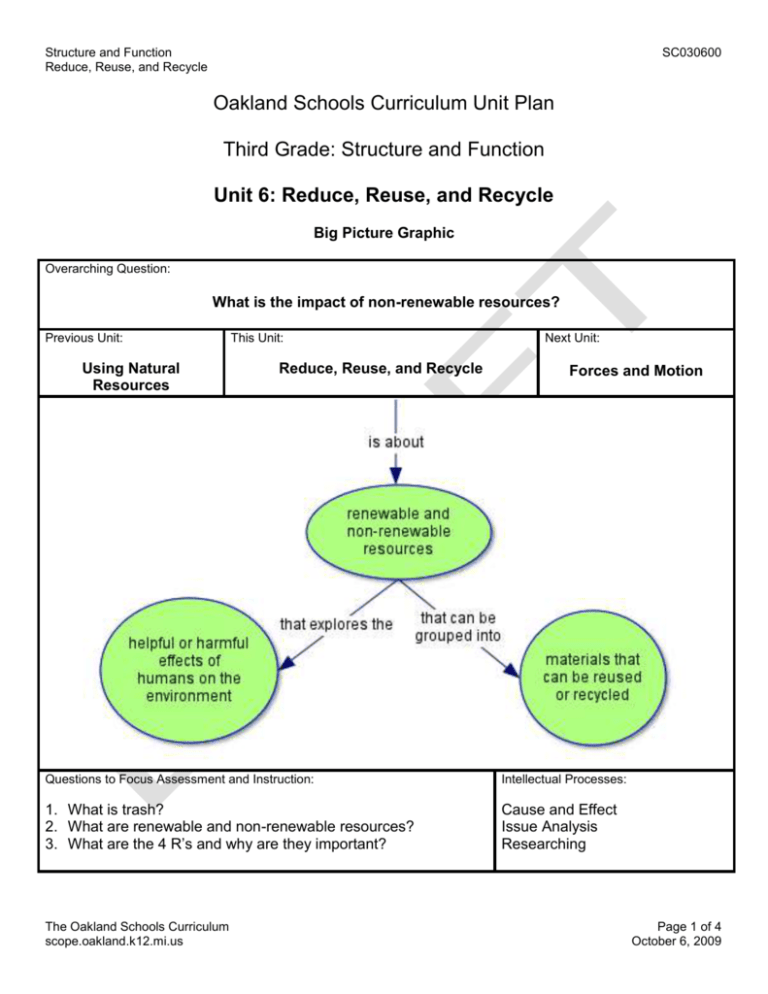
Structure and Function Reduce, Reuse, and Recycle SC030600 Oakland Schools Curriculum Unit Plan Third Grade: Structure and Function Unit 6: Reduce, Reuse, and Recycle Big Picture Graphic Overarching Question: What is the impact of non-renewable resources? Previous Unit: Using Natural Resources This Unit: Reduce, Reuse, and Recycle Next Unit: Forces and Motion Questions to Focus Assessment and Instruction: Intellectual Processes: 1. What is trash? 2. What are renewable and non-renewable resources? 3. What are the 4 R’s and why are they important? Cause and Effect Issue Analysis Researching The Oakland Schools Curriculum scope.oakland.k12.mi.us Page 1 of 4 October 6, 2009 Structure and Function Reduce, Reuse, and Recycle SC030600 Unit Abstract This earth science unit focuses on what students can do within their homes and school to create habits regarding recycling. They begin with classification of renewable (i.e., fresh water, farmland, forests) and non-renewable (i.e., fossil fuels, metals) resources. Students begin to explore the helpful and harmful effects that humans have on the environment, such as habitat destruction and land management. They discover various ways that they can protect, extend, and restore various resources – recycle, reuse, reduce, and renewal. Students learn what trash is, the effects of littering, and inappropriate waste disposal. They classify litter according to material type, such as paper, plastic, metal, and glass and recognize that it can be recycled. Students explore what happens to trash after it leaves their home or school and are introduced to the purpose of landfills. Grade Level Content Expectations Students will: classify renewable (fresh water, fertile soil, forests) and non-renewable (fuels, metals) resources (E.ES.03.42). describe ways humans are protecting, extending, and restoring resources (recycle, reuse, reduce, renewal) (E.ES.03.43). describe helpful or harmful effects of humans on the environment (garbage, habitat destruction, land management, renewable and non-renewable resources) (E.ES.03.52). recognize that paper, metal, glass, and some plastics can be recycled (E.ES.03.44). share ideas about recycling through purposeful conservation in collaborative groups (S.IA.03.12). identify current problems regarding renewable and non-renewable resources that may be solved through the use of technology (S.RS.03.17). use evidence when communicating ideas about how to recycle within your school or home (S.RS.03.15). Key Concepts habitat destruction litter/trash recycle reduce renewable/non-renewable resource renewal reuse Duration: 4 – 6 weeks Supplemental Materials SCoPE Lesson 1 SCoPE Lesson 2 SCoPE Lesson 3 The Oakland Schools Curriculum scope.oakland.k12.mi.us Page 2 of 4 October 6, 2009 Structure and Function Reduce, Reuse, and Recycle SC030600 SCoPE Lesson 4 SCoPE Lesson 5 SCoPE Lesson 6 SCoPE Lesson 7 SCoPE Lesson 8 SCoPE Lesson 9 SCoPE Lesson 10 Recommended (not required) Instructional Resources Student Resource Hewitt, Sally. Reduce and Reuse (Green Team). New York: Crabtree Publishing, 2008. ---. Waste and Recycling (Green Team). New York: Crabtree Publishing, 2008. ---. Your Local Environment (Green Team). New York: Crabtree Publishing, 2008. Robinson, Fay. Recycle That. Danbury, CT: Grolier Publications, 1995. Suid, Annalisa. Learn to Recycle. Palo Alto, CA: Monday Morning Press, 1993. Williams, Rozanne, and Neena Chawla. Reduce, Reuse, Recycle. Fresno, CA: Creative Teaching Press, 1995. Teacher Resource Garbage 1: The Roots of Trash. 2006. AAAS – Science NetLinks. 11 February 2008 <http://www.sciencenetlinks.com/lessons.cfm?Grade=3-5&BenchmarkID=8&DocID=384>. Garbage 2: Recycling. 2006. AAAS – Science NetLinks. 11 February <http://www.sciencenetlinks.com/lessons.cfm?Grade=3-5&BenchmarkID=8&DocID=386>. 2008 Michigan Department of Natural Resources, Waste Management Division, and the Michigan Department of Education. Project Wise. Lansing, MI: Michigan United Conservation Clubs, 1996. Sample Performance Assessments 1. Illustrate the “life” of a piece of trash (E.ES.03.52). 2. Given a grouping of resources, work in small groups to classify as renewable or non-renewable (E.ES.03.42, S.IA.03.12). 3. Choose a piece of trash and explain ways in which it could be reduced, recycled, or reused (E.ES.03.43, E.ES.03.44, S.RS.03.15). 4. Give examples of ways in which the school is being wasteful, explain how one of these examples could effect the natural environment, and provide at least one solution to help alleviate the waste (E.ES.03.42, E.ES.03.52, S.RS.03.17, S.RS.03.15). The Oakland Schools Curriculum scope.oakland.k12.mi.us Page 3 of 4 October 6, 2009 Structure and Function Reduce, Reuse, and Recycle SC030600 Connections Mathematics While studying recycling students can measure the amounts of various types of trash discarded by the school. Social Studies While studying recycling, students can connect to the concept of social responsibility. The Oakland Schools Curriculum scope.oakland.k12.mi.us Page 4 of 4 October 6, 2009

